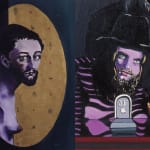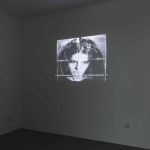
Exhibition view, Thinking Ahead, Erna Hecey Gallery, Luxembourg, 2018
Roee Rosen
Two Women and a Man portrays the fictive character of Justine Frank by presenting segments from an interview with yet another fictive persona, Frank's scholar and the translator of her book to Hebrew. The televised interview serves not only to survey Frank's work, but also to launch an assault against Roee Rosen, and his manipulative appropriation of Frank's legacy.
Justine Frank (Born: Anwerp, 1900; died: Tel Aviv, 1943)
The art of the fictive Jewish Belgian painter Justine Frank has long been neglected and suppressed. Her work joins erotic motifs and Jewish imagery-a disturbing, hallucinatory combination. The same mixture of smut and Jewish tropes appears in the only book she authored, the pornographic novel Sweet Sweat (1931).
As soon as Frank emigrated from Antwerp to Paris, she mingled with members the Surrealist movement. While the Surrealists advocated a radical investigation of sexuality, the place allotted women-artists in this enterprise was rather scarce, and the scatological nature of Frank's imagery repelled them. The Jewish tropes in Frank's paintings were an anomaly as well. While a sacrilegious assault on Catholicism was a staple of Surrealism, Jewish Surrealists abstained from addressing this facet of their identity in their art-and Frank's spectacle of Judaism was far too baffling to be understood as merely satirical.
Frank's career was also hindered by her intimate relationship with controversial author Georges Bataille, who at that time was having a veritable war with Surrealist leader André Breton. Her personal, financial and professional difficulties, along with the ominous intensification of anti-Semitism in Europe finally brought the artist to emigrate to Palestine in 1934. She settled in Tel Aviv, hometown of her best friend, Fanja Hissin, a kiosk owner widowed a year earlier. Yet opting for Tel Aviv was odd, if not tragic. Frank had always disavowed nationalist ideologies; once in Tel Aviv, her attitude became one of manifested hostility towards the values of the Zionist society. She persisted with her disagreeable artistic amalgamation of erotica and Judaism in the context of a puritan culture, whose "melting pot" ideology called for the suppression and negation of the diasporic Jew Frank was so adamantly rendering.
Frank was living virtually as an untouchable. But the social banishment did not prevent an unremitting buzz of ill-willed gossip around her. Some of these rumors were patently false. But as the years went by and her condition deteriorated further, her behavior did indeed become more disconcerting. In 1940 she began to persistently pester Marcel Janco, the venerated artist and recent immigrant. For her, it seems, Janco was simultaneously an alter ego, a nemesis, and a traitor, exchanging the radical stance of the avant-garde for nationalist local patriotism.
On April 22nd, 1942, Frank arrived as an uninvited guest, at the opening of an exhibition entitled Desert Light and Light Unto the Nations. According to most accounts, Frank attempted to assault Janco, and was arrested. Whatever truly happened, the event had doubtlessly scarred Frank. After Fanja Hissin bailed her, she moved in with the widower. In the early afternoon hours of April 12th, 1943, Justine Frank left Hissin's apartment. She was never seen again.




